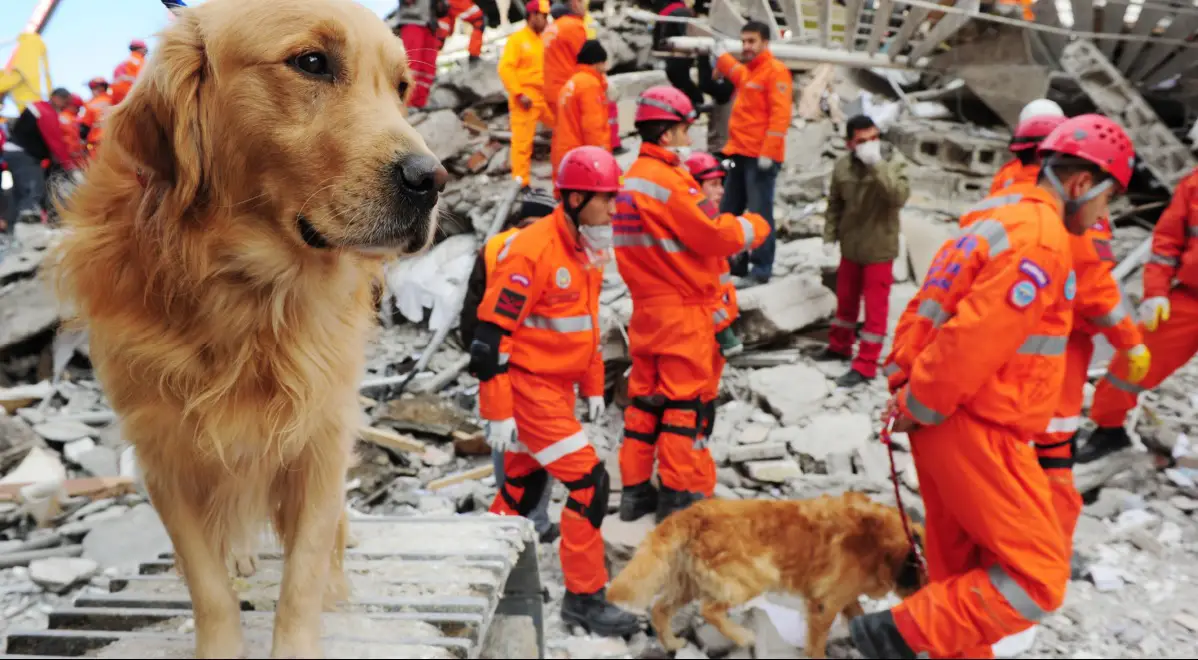The earthquake that hit Türkiye and Syria has been named the Catastrophe of the Century, perhaps even the Catastrophe of the Millennium. Do you agree with that?
In Türkiye there are three seismically active fault lines underneath the country and the seismically active fault line that broke on 6 February was one that hadn’t been active for quite some time. All of the country’s geologists and seismologists were saying that this would happen, but nobody was expecting it to be so big. There were two of them – one after another, which doesn’t usually happen. A seismic fault line doesn’t break in two places at the same time. So in the early hours of the morning we experienced a very big earthquake and the next morning a second earthquake followed.
On the same fault line?
The same activity on the same fault line. And, of course, there were many secondary earthquakes related to these main earthquakes – even those measured above five, six points on the Richter scale. It was a calamity on a Biblical scale. There was a lot of damage. Had it been only one earthquake, the damage might not have been so severe. The first earthquake uprooted a lot of buildings and did a lot of damage, but then the second earthquake hit, so there were two earthquakes at the same time.
When did the last earthquake before 6 February 2023 occur?
There are regular earthquakes, because it is a seismically active zone. On both sides of the border between Greece and Turkey there are small earthquakes that happen regularly measuring over three or four points on the Richter scale. The last big earthquake hit in 1999 in the city of Yalova on the coast of the Sea of Marmara which is situated in the West of the country. And then in the 1980s, at the beginning of the 1990s two other earthquakes hit, both were in the East of the country and those were quite big as well. So we are used to having a lot of earthquakes. But the problem is that now these big fault lines have come to maturity in terms of energy – they have accumulated a lot of energy and they need to break and the energy needs to be released. Seismologists and geologists are telling us that the breakage is going to move further north and west. So there is a possibility that it will hit other cities, such as Adana, Erzincan and it might also come to Istanbul.
This information is new to me, to be honest.
We are in the process of tearing down all the housing that was affected by these earthquakes, because the buildings are heavily damaged and need to be torn down.
How many districts, cities and towns were damaged during the earthquake?
The area concerned is bigger than Austria, Belgium, the Czech Republic or Slovakia altogether. In fact, you can say it’s bigger than the territory of Austria and the Slovak Republic together – about fourteen million people and about eleven provinces. It is a very populous area. Hundreds of thousands of homes were demolished. A lot were heavily damaged, but even those less damaged will be torn down. The government has enacted a law under which the government will be financing new homes built according to new standards in different regions.
Is it possible to give everybody a new apartment?
Yes, because this is something that needs to be done. We will be working on it as during the previous earthquakes. Those who can afford to pay – those with businesses or financing, will cover the cost of reconstructing part of the building. But those who have lost their property, livelihood or businesses will not pay for anything. The government will subsidize the reconstruction of those buildings.
But, on the other hand, institutions and hotels are most probably covered by insurances.
Hotels have insurances, but at the end of the day all the people working at a hotel are common people who lost their homes without insurance. There is a national agency dedicated to rebuilding homes called TOKI has been given the task of creating several hundred thousand new homes. When the earthquake hit, there were two problems: the fact that this area includes ancient cities, especially Hatay, Maraş, Antakya, Şanlıurfa are old civilizations in the centres of Mesopotamia. In these civilization centres everything was built around the river – around mosques, churches, synagogues situated together like in Antakya – thousand-year-old buildings built on geologically soft land because of the water underneath. With time, apartments were built around them. In an earthquake-prone zone you don’t build apartments in such places, but because the city had been there for a couple of thousand years, they continued living in the area. That is the nature of the first problem. Another problem was the sequence of two earthquakes – one after another. And the other issue was the fact that in 1999, when the earthquake hit, we introduced regulations to build buildings that were as severe as the ones in Japan. But, unfortunately, the regulations were not adhered to. In a city you could see buildings that stood firmly and unaffected as they had been built according to the standards of these regulations. The buildings that collapsed were substandard. Now all of the engineers and architects that built those substandard apartments are being called in, questioned or arrested because they didn’t apply the earthquake zone regulations, but they built apartments according to regular standards.
I have watched in BBC newsflashes the affected buildings collapse.
Buildings have main pillars that carry them. The pillars in an earthquake zone have to possess a seismic mobility apparatus installed underneath. The problem is that apartments were built in Antakya without this apparatus. When an earthquake hits, there is a need for this seismic stabilizer and the carrying columns of the buildings need to be structured much more heavily than regular columns so that they can withstand the force created by the earthquake.
Now I understand why the scale of the catastrophe was so big.
This was a big and a very unfortunate wake-up call. Now we are going into every single city where the housing was built on a terrain that is not suitable, with the task of rebuilding the cities where necessary.
…and move people to another region?
…not region, but in the same city to areas that are situated on geologically speaking rock formations made of stone. So a city should be constructed near the mountains on rock formations. For example, the city of Adıyaman will be relocated to an empty area behind the city towards the mountains. The current city centre will be transformed into parks or recreation areas and the whole city will be transferred to the mountain side.
How many countries were involved in providing aid?
More than 65 countries sent search and rescue teams. More than a hundred and fifty countries sent financial aid or other forms of donation. We declared level 4, which is the highest level of civil emergency. When that call goes out, all the countries are obliged to answer if they have declared joining the world system in that respect.
How did Poland support Turkey?
Poland’s reaction was great. Polish people, the Polish government and the state responded in an amazing way. Poland was one of the first countries that in a very short time prepared a USAR team – a heavy search and rescue team. A very professional team with eight search and rescue dogs went there and saved twelve people from the rubble. They worked there for quite a long time. Some miners participated as well. There was also a Polish field hospital set up. Apart from that, the Polish state also sent some medical aid as well. Here there were centres for collection of donations opened to the public. Polish people came to eight embassy centres opened in Poland and voluntarily donated all forms of aid. We had a list of what was needed – because it was wintertime and cold, a lot of winter clothes were needed, so we were able to provide them. In terms of financial donations, people donated money into a special account that we opened in a Polish bank (it is still active). As a result of these donations we were able to buy twelve special containers serving as a bathroom and a toilet at the same time. We also sent a lot of equipment like generators, batteries, tents, etc. with Turkish airlines. The Red Cross collected money and donations from people. There were other Polish charity organisations helping Turkey as well.
How many Polish organisations were involved in the process?
I don’t know the exact figures but I know about ten different organisations that actually did a lot. For example, in schools there were many seven- or eight-year-old schoolchildren coming to us with an envelope saying that they had collected money, their own pocket money, to be sent in envelopes to the children affected in Turkey. And that was so touching. Some schools organised charity donation concerts or charity evenings with Turkish food.
It is nice to hear that Polish people were so involved…
Polish people show that they are a very caring nation with open hearts. Poland did the same for Ukraine and we knew that you were very caring. You did the same for the earthquake victims as well.
I have read that Türkiye supported Syria – is it true?
The region that was hit was very close to the north of Syria – an area controlled by people who have run away from the Syrian regime, which was not able to help out in that region. The UN system operates from Türkiye and all of the aid comes from Türkiye under regular conditions – we have built up schools, hospitals etc. there. When the earthquake hit, we opened the borders – even the ones closed at the moment – so that aid from international sources could flow in. We provided our own aid and did whatever we could in the north of Syria as well.
It is an exemplary form of behaviour in such a grave situation.
This is humanity. This is a natural calamity – it happens where everybody is affected in the same way. You have to help people out in such circumstances. We were glad to help with all of the International aid coming in. A lot of countries sent aid to the earthquake victims in both Türkiye and Syria and from Türkiye to Syria as well.
What was the total cost of the damage?
We don’t know the total cost of the damage. It still needs to be estimated. But we do know that it will cost tremendous amounts of money. The damage itself is huge because there are hundreds of thousands of buildings that need to be demolished. The infrastructure, hospitals, schools are being demolished; the airports and the main roads have been re-opened. Now we are in the process of bringing back the water and electricity supply to the cities. But I think it will be more than a hundred billion dollars, definitely. And the reconstruction of the new buildings, etc. will cost a tremendous amount of money in more than just the region concerned. We will go to other cities which we expect to experience earthquakes in the forthcoming future.
What are you going to do?
Now everybody is looking at their houses and calling in engineers specialized in checking the structures of buildings. And if the structure of the building they live in is substandard, people move out to relatives and friends and a lot of buildings will be torn down and rebuilt in Istanbul. What happens is what we call ’the rejuvenation of cities’. All the neighbors in a building get together, apply to the state and the municipality to give the property to the state saying that if one has a hundred and twenty square meter apartment, after the whole apartment is torn down when everybody agrees in the building, the state rebuilds this building according to new structure rules and regulations. But the state gives back not an apartment of a hundred and twenty square meters, but, for example, an apartment of ninety square meters. Why? Because the state takes one floor and sells it to have money for the reconstruction of that building under the proper earthquake standards.
Is this a new idea?
So far, since 1999, we have rebuilt half a million houses already within the system. People now have modern and safe homes to live in.
So you have gained the necessary experience.
Yes, but the process will speed up. The state will pay for it. But for people who live, for example, in Istanbul now knowing that their houses are not in a proper state, a new law will be enacted that they will be obliged to hand in the property to the state and go with their families to live to another place until their building is renewed, and then they will come back. So everything will be renewed.
It means a lot of work ahead of you.
A lot of work, but it needs to be done. And this was a compulsory and an obligatory wake-up call for everybody. And what’s more, what came out as a very important thing is the fact that people understood in a very unfortunate way that human life is not worth saving money over building standards. Human life is much, much more important than anything else.
What can we wish the people of Türkiye?
Wish us good luck.
Of course, we do. Is there anything else we might wish you as well?
First of all, it’s a very dire situation – a lot of people have been affected. More than fifty thousand people died. More than a hundred and fifteen thousand people were injured. And the death toll is still rising. It was a very grave situation, unfortunately. So prayers and good faith are the best thing. The rest now is up to us. We have to work very hard to restructure our cities and realize that while building modern cities in an earthquake zone you have to be as strict as the Japanese. Unfortunately, we were complacent and we have to work very hard now to remedy our mistakes. So wish us good luck.
One last question: is Türkiye a safe place for Polish tourists to visit?
The zones that were affected and the zones that might be affected in the future are quite far away from the areas that Polish tourists enjoy – beaches near the sea. In fact, we would promote Türkiye as a holiday destination as every penny spent by a Polish tourist will go to restructuring the country. So it will be good in that sense as well.
Thank you for your time. It was a pleasure to meet and talk to you.
The pleasure is mine.
Rozmawiała
Ada Krzewicka



Sledź nas na: